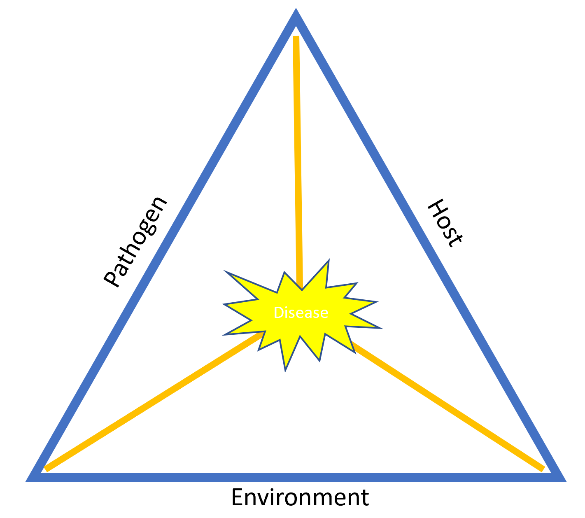In 2018 I received some images on my cell phone. These images were of red crown rot, a soybean disease I had encountered while I was the field crop pathologist at the University of Delaware. The images clearly showed distinctive brick red, pinhead sized “balls” aggregated on the lower stems of the plant. My immediate response to the individual who sent the images was “That’s red crown rot (RCR)- It’s typically a non-issue and routinely found in... Read More →
ILSOYADVISOR POST
What Is the Disease Triangle?
March 17, 2020
Have you ever wondered why certain diseases cause problems during certain seasons but not others? A disease is a living organism that wants to feed, thrive and reproduce. However, depending on the growing season, producers may see variability in disease presence. The seasonal occurrence will be strongly determined by collective interaction of these three factors: host, pathogen and environment.
 The Susceptible Host: A soybean seed or a soybean seedling
The Susceptible Host: A soybean seed or a soybean seedling The Pathogen: Rhizoctonia, Phytophthora or Pythium
Environment:
- Cool/wet soils 50-60 degrees
- Warm/wet soils 75-80 degrees
- Slow growing conditions
Below is a chart showing how any of the three can change from season to season or even field by field, which can indicate how aggressive an issue may be. As you can see, disease pressure and occurrences are strongly dictated by the environment. Integrated Pest Management (IPM) can be implemented to manipulate the disease triangle to proactively minimize the risk.
Here are a few management examples to consider:
- Utilizing seed treatments
- Genetic selection
- Proper field placement
- Rotation of genetics
- Rotation of crop
- Planting dates
- Row spacing
- Population
- Residue management
- Tillage/No-till
 At the end of the day, producers are placing a very vulnerable seed into a very biologically active environment. By nature, these diseases are just looking for an energy sources to live and reproduce. However, their survival means the depletion of our soybean crop, which can lead to replanting and lost yield. It’s important to do your research about the potential upcoming risk for the 2020 planting season and take any and all proactive measures to preserve your soybean stand.
At the end of the day, producers are placing a very vulnerable seed into a very biologically active environment. By nature, these diseases are just looking for an energy sources to live and reproduce. However, their survival means the depletion of our soybean crop, which can lead to replanting and lost yield. It’s important to do your research about the potential upcoming risk for the 2020 planting season and take any and all proactive measures to preserve your soybean stand. NOTE: There are a lot of products on the market that are available to producers—such as seed treatments—that can help suppress issues, but it’s important to know that it is very difficult to protect 100% of a population. Especially if disease population is high, the environment is very stressful and the crop is growing slowly. In other words, in production agriculture nothing is 100% effective or risk free.





Comments
Add new comment